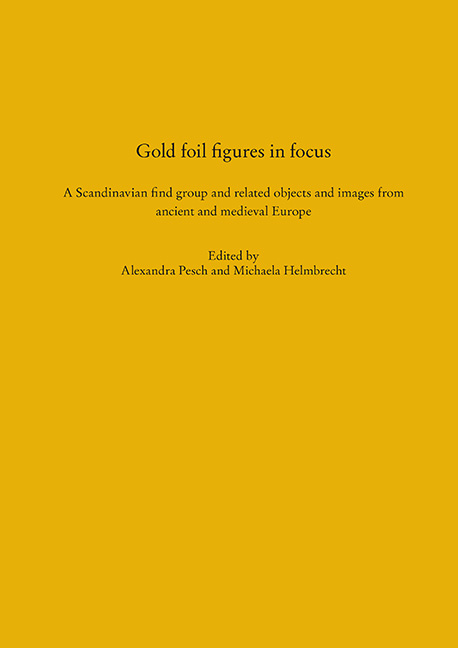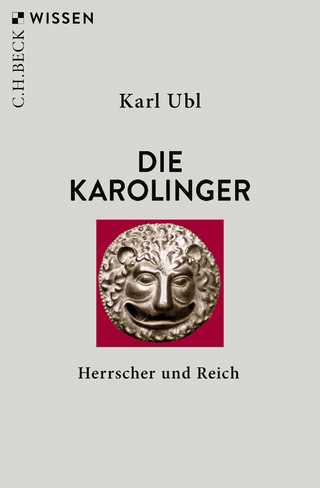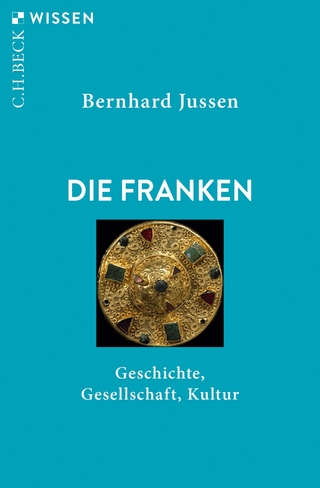
Gold foil figures in focus
Pfeil, F (Verlag)
978-3-89937-249-6 (ISBN)
Foreword 7
Preface 9
Setting the stage (Alexandra Pesch, Michaela Helmbrecht) 11
Gold foil figures – fact and fiction? (Margrethe Watt) 35
Scandinavian imagery
Gestural expressions in Norwegian Style I (Siv Kristoffersen) 73
Human images in the art of Scandinavia, 4th–6th centuries AD. A stylised abstraction of the human form in ritual disguise (Bente Magnus) 83
Scandinavian figurines – relatives of the gold foil figures, and a new find from Old Uppsala (Torun Zachrisson) 105
The gold foil figures within the imagery of the Vendel Period and the continuation of their motifs into the Viking Age (Michaela Helmbrecht) 131
Other imageries and image aspects
Framing matters (Charlotte Behr) 151
From Rome to the Viking Period: an overview of anthropomorphic imagery from the British Isles (Sonja Marzinzik) 171
Menschenbilder der Kelten – Anthropomorphe Darstellungen der Eisenzeit in Mittel- und Westeuropa (Jennifer M. Bagley) 205
Anmerkungen zum Verhältnis der skandinavischen Goldblechfiguren zur Kunst der Römischen Kaiserzeit (Manuel Flecker) 229
Gold, Geld, Glaube – Frühbyzantinische Goldobjekte und deren figürliche Darstellungen (Yvonne Petrina) 239
Late Roman Period gold foil pendants stamped with anthropomorphic and zoomorphic ornaments found in the Barbaricum (Kyrylo Myzgin) 255
Fingerspiele – (Mittelalterliche) Gesten und Goldblechfiguren (Axel Christoph Gampp) 279
A world of warriors?
Continental figural repoussé works of the Merovingian Period (Michaela Helmbrecht) 291
Kaftan, Straffhaar und Stab. Ein Goldblechfiguren-Motiv und die Bilderwelt Europas im 6.–9. Jahrhundert (Egon Wamers) 313
Images of Roman and Byzantine imperial dress – inspiration for the Scandinavian gold foil figures? (Svante Fischer) 339
Research history and special questions
Communicating with the gods via humanoid images – the meaning and function of the gold foil figures with pairs in the view of history of religions (Olof Sundqvist) 359
Karl Haucks Studien zu den skandinavischen Goldblechfiguren – Zusammenfassung, Kritik und neue Überlegungen (Sigmund Oehrl) 389
Gold foil figures in focus: results of workshop I
Gold foil figures in focus: synthesis and results (Alexandra Pesch, Michaela Helmbrecht) 427
At first glance, it might appear a bit premature to present a comprehensive volume about the gold foil figures and the iconography of their time, given the fact that many of those tiny, enigmatic objects are still unpublished. On the other hand, during the past 30 years our knowledge has been greatly enhanced through specialised research. Especially thanks to the extensive studies and writings of Margrethe Watt, the true grande dame of the subject, it seems that we actually know enough about the overall designs of the gold foil figures to venture a closer look and undertake a general analysis of the composition, function, and meaning of this ‘charming’ material. Thus, the Centre for Baltic and Scandinavian Archaeology (ZBSA) in Schleswig launched an international and interdisciplinary research project on the gold foil figures in 2015. Its aims were: – firstly, to investigate the relationship of the gold foil figures’ imagery to contemporaneous imageries in the North and neighbouring cultures, and – secondly, to collect and re-evaluate the archaeological information around the gold foil figures (see chapter SETTING THE STAGE). The initial workshop took place in 2017, with invited researchers from nine specialist disciplines and eight countries present, among them especially the Scandinavian scholars who first handled the material. The chapters in this book are the result of that meeting. It continued the tradition of the workshop programme at the ZBSA primarily developed and pursued by Oliver Grimm and Alexandra Pesch. By using large-scale reflections, it aims to direct prominent and current subjects with a main focus in the 1st millennium AD towards comprehensive syntheses and results. This takes place by means of well-structured workshops and with the active participation of specialised researchers from different subject areas. An important factor is their meticulous planning and preparation in advance, by formulating both general and specific central questions and by sending the abstracts of the proposed presentations to all attendees well before the event. At the meeting, the individual topics are presented and discussed in detail. This process is enhancing the presenters’ manuscripts, which subsequently are developed even further, in coordination with the editors and by mutual and/or external peer reviewing, into specialised chapters. United in a comprehensive anthology also reflecting the workshop’s overall conclusion, the results are then scheduled for nearterm publication. Between autumn 2009, when the ZBSA was founded, and 2018, seven such events have taken place (apart from other conferences and work meetings at the ZBSA), and with this volume, they all are published now. We are very glad that it was accepted to the “Schriften des Museums für Archäologie, Ergänzungsreihe”. Many persons are involved in the production of a book such as this, whether directly or indirectly. Not all of them can be mentioned here. But we would like to express our gratitude not only to the authors of this volume, but also to the workshop’s other participants and helpers: in a cooperative and constructive manner (and this needs to be emphasised), they collectively laid the foundation for this book. Unfortunately, a major application for third-party funds to help finance the overall project was unsuccessful, and this caused some headwind, especially during the project’s period of consolidation. Therefore, our gratitude is due first and foremost to the “Verein zur Förderung des Archäologischen Landesmuseums e. V.”: from the funding for research trips both short and long and the provisioning of the workshop with necessary materials to generous printing subsidies, our numerous petitions and applications – helped along through mediation by Ute Drews – were handled professionally, efficiently, and favourably. Without this support, the project would not have been possible. The expenses of the workshop (such as travel and accommodation of the invited guests), were covered by the ZBSA. Though this seemed to have been an unreasonable demand, the administration generously agreed to pay the lion’s share of dozens of bills. The rest of the costs were met through private donations. Furthermore, the ZBSA also paid for the textual, editorial, and graphic work on this book as well as for a part of its printing, which represented the main chunk of the money required. During this process, Doris Rohwäder, ZBSA management, always was a great and reliable help. For her many helpful tips and good ideas, we offer our profound thanks. Where necessary, translations and linguistic revisions of texts and abstracts were attended to by Dr. Jennifer M. Bagley, Dr. Charlotte Behr, Prof. John Hines, Beverley Hirschel, Dr. Sonja Marzinzik, and especially Dr. Dirk Steinforth. The new maps of the gold foil figure distribution reproduced in this book were prepared by the GIS department of the ZBSA, expertly led by Karin Göbel, who has our special gratitude for her professional and valuable support. Highest accolades deserve ZBSA staff members Isabel Sonnenschein (responsible for editing and content control) and Matthias Bolte (graphics and disaster prevention) for their diligence and creativity in checking the submitted contributions for formal and textual shortcomings as well as the creation of the final print templates. In doing so, they also had to grapple with the editing, optimisation, scaling, and fitting of the about 560 individual images of this volume, but mastered this task with exemplary equanimity and humour. Performances like these often go overlooked, but without them, nothing will work out. We are very glad to present this book – realised by collaborative efforts and after having overcome the usual as well as additional difficulties and obstacles – to our readers and hope that it may provide to both academic researchers and the interested public a well-founded basis for further investigations of a fascinating, and in some aspects rather current find group. We dedicate this volume to the memory of Prof. Dr. Heinrich Beck (1929–2019). In many years of fruitful research, he fostered and promoted the spheres of Scandinavian philology including archaeological aspects (Germ. “Altertumskunde”). We remember him as a courteous, generous, supportive and truly knowledgeable scholar and senior colleague. Among other things, his accomplishments in approaching the semantic meaning of images on archaeological objects from the Migration Period to the Viking Age and especially from the Vendel Period produced remarkable and highly recommendable results and inspired us deeply in our own research. Schleswig, August 2019 The editors Alexandra Pesch, Michaela Helmbrecht
| Erscheinungsdatum | 21.01.2020 |
|---|---|
| Reihe/Serie | SCHRIFTEN DES MUSEUMS FÜR ARCHÄOLOGIE SCHLOSS GOTTORF ; 14 |
| Zusatzinfo | 452 Seiten, 349 meist farbige Abbildungen, 3 Tabellen |
| Sprache | englisch; deutsch |
| Themenwelt | Sachbuch/Ratgeber ► Geschichte / Politik ► Mittelalter |
| Schlagworte | Archäologie • Baltische und Skandinavische Archäologie • Gold foil figures |
| ISBN-10 | 3-89937-249-2 / 3899372492 |
| ISBN-13 | 978-3-89937-249-6 / 9783899372496 |
| Zustand | Neuware |
| Haben Sie eine Frage zum Produkt? |
aus dem Bereich


